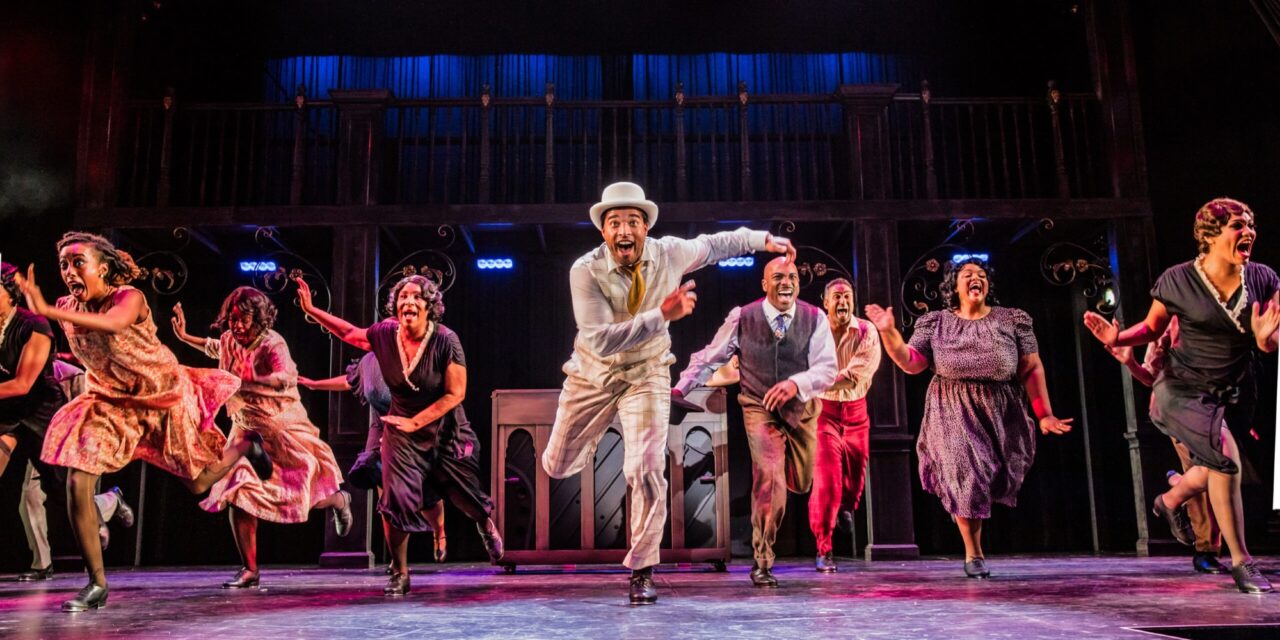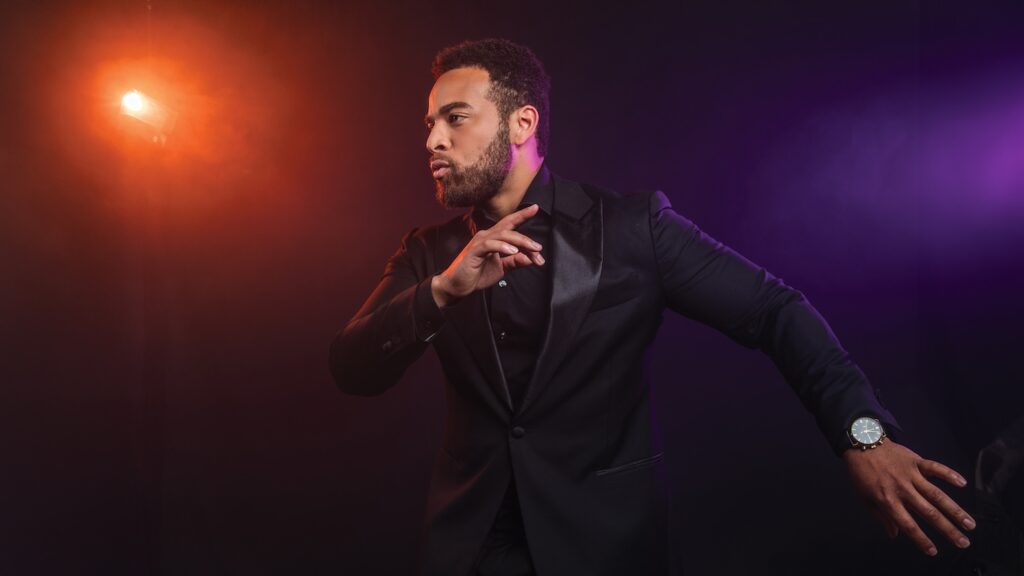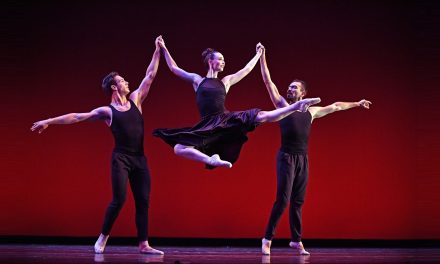With the opening of the musical Jelly’s Last Jam at the Pasadena Playhouse, this song and dance drenched consideration of the audacious, self-proclaimed inventor of jazz comes home, so to speak. The jazz-infused recounting of the turbulent life and times of jazz legend Jelly Roll Morton premiered in 1991 at Los Angeles’ Mark Taper Forum under Gordon Davidson. Written and directed by George C. Wolfe, the LA premiere led to a Broadway production in 1992 with Gregory Hines in the lead and Wolfe directing. The show garnered eleven Tony nominations, winning four Tony Awards including for Wolfe’s writing and Hines’ performance. It’s back in LA, well, next door in Pasadena.
Wolfe started with a series of interviews in 1938 with Ferdinand Joseph LaMothe, who renamed himself Jelly Roll Morton, then wove Morton’s music into the five decade story of the achievements and contradictions “in the life of an arrogant, racist, braggadocio genius,” as Wolfe described Jelly Roll Morton in an interview with Playbill’s Tony Perkins. “Morton was an American who proclaimed himself pure. But there is no purity in American. We are all mutts. I was fascinated by the absoluteness of his declaration.” Wolfe continued.
For this new revival, Pasadena Playhouse director Danny Feldman brought in director Kent Gash, who in turn brought in choreographer Dell Howlett.
Along with the musical returning after three decades to where it premiered, this revival also is a homecoming for the director and choreographer who first worked together 20 years ago, and the show they worked on was Jelly’s Last Jam.
Howlett took time from rehearsal to talk with LA Dance Chronicle’s Ann Haskins about the show, how choreography fits into this revival, and his personal history with the show.
LADC: As Head of Dance at NYU/Tisch School of the Arts in the Department of Drama’s New Studio on Broadway, Pasadena is a long way from home for you. How did you become involved with the Pasadena Playhouse?
Howlett: Well, I have worked with the director Kent Gash on a number of projects, including Billy Strayhorn: Something To Live For. Pasadena Playhouse artistic director Danny Feldman knew that about 20 years ago Kent directed a production of the show at Atlanta’s Alliance Theatre that received a great deal of positive critical response. Kent called and said ‘I’m doing Jelly’s Last Jam again, and I know last time we did it, almost 20 years ago, you were in it. This time, I’d like you to choreograph it.” That earlier production, I was in my mid-20s, right out of college. So this production is a full circle moment for me; this time coming to the other side of the table on it.
LADC: Do you view the show differently after 20 years?
Howlett: The show deals with a lot of very sophisticated and mature subject matter. After 20 years, my brain appreciates what is in the show, especially now that I’m choreographer. In the Alliance Theatre production, I played Three-Fingered Snake, a featured ensemble role. I also became associate choreographer, my first time having some relationship to what the show was doing dance wise. Until then, I had been just a contemporary ballet dancer and a jazz dancer and hadn’t really considered things outside of my technical jazz training. I did not appreciate what social and vernacular jazz dance really was. We’re talking about slang and Lindy and tap, and the type of dance that would have gone hand in hand with the type of music Jelly Roll Morton was making. So the show was my first introduction to that as well.
LADC: Where does dance factor into this production and with the constraints of the Pasadena Playhouse stage.
Howlett: Yeah, it’s an interesting space, isn’t it? Well, you know, it’s one of the things that I really believe about musical theater work in general, which is that musical theater is about synthesis, right? How all of the different elements—music, dance, costumes, scenery—how they all coalesce and become one thing. I was very excited to address the show and bring choreography to that larger vision.
I started tapping a long time ago. My ankles don’t move necessarily the way they used to, but I think of tap as music making. I start with the rhythm that I want and then I work it out in the ankle. We’ve worked that way in terms of creating the tap for the show, and also all of the other different elements of jazz dance, the different kinds of rudiments whether the African and swaying, and more theatrical dance in the realm of Bob Fosse. The show has some vaudeville. We’ll get some soft shoe. We’ll see step dancing. We’ll get some hamboning, which is a form we don’t see much of anymore, but something that I really have a great fondness for, especially as it proceeds tap. So we’re embodying rhythm and syncopating, not just in the feet in tap dancing, but in all parts of the body.
When George Wolfe talked about the show and the original genesis of the show, you can hear he was really inspired by tensions inherent in the theater, of the dark world that was just waiting in the wings about to come on stage. But what happens if we bring that dark world on stage? So much of the dancing in the show is influenced by that impulse, some Brechtian quality of the acting underneath the dancing.

Janaya Mahealani Jones, Naomi C. Walley, and Cyd Charisse Glover-Hill in “Jelly’s Last Jam” – Photo by Jeff Lorch.
LADC: Does the dancing evolve with the chronology of Jelly Roll Morton’s life?
Howlett: The show is Jelly Roll Morton’s journey reviewing his life while he’s in purgatory, a limbo state after he’s died, so the action exists outside of space and time. We kind of start at the beginning, with young Jelly. It does shift among time periods, but there is a chronology that we can hold on to. I started with the homies who are a kind of the Greek chorus and the three glamorous, dark ladies who are a kind of black bottom performance at the top of the show. Then we move into New Orleans’ Congo Square where young Jelly learns the bass pulses that become the basis for his syncopation, which present as African drumming. So we start with an African idea at the beginning of the show. From there, we’re looking at vaudeville, and then tap, then jazz, which is not so much performance tap, but almost like surfing. When we move into the back end of Act One, the action goes into more of a performance, Broadway style tap. I won’t give away the theatrical idea behind it because it’s kind of a dark one. But we do see a stylistic change.
In Act Two, when Jelly goes to New York and in his later years, we see the advent of swing dancing. All of a sudden, we see what it means to swing out. So there is a kind of chronology of jazz dance in America, rightly at the heart of the piece with the music.
LADC: Looking at the bios of the leads, they have tremendous acting and singing credits, but not much about dance. How did you work with that?
Howlett: Well, one of the things that I have absorbed working with Kent Gast over many projects, is that in every show he does, everyone dances. In his shows, everybody on stage, and I mean literally everybody on stage, is able to channel rhythm and able to find what their version of the dance is. Those are things that we investigated in the audition process. So even though people may not have formal dance training, everyone in the show has been auditioned in a way that they have some groove. That gives me some way of entering their dance aesthetic by way of how they naturally move. So John Clarence Stewart, our Jelly, is a such a dynamic, natural rhythm-making actor, singer, musician, and I’ve just been able to take what’s naturally inside of him and build an aesthetic that’s basically his. And that’s how I’ve been looking at all the leads, trying to make aesthetics that are particular and indelible for the characters that they’ll be portraying. You have a lot of folks who have a movement capacity, if not formal dance training. For others, their formal dance training is at the heart of the show in the social and vernacular jazz.
I remember Broadway productions I was in where rehearsing dance felt severe, devoid of joy. One of the ways that I’m finding full embodiment, is always trying to make a larger, more robust invitation with a joyful ethos underneath it. So we always warm up together by way of some social dance. That’s the first thing, all of us together in the room, and I always start any of the movement with finding the natural rhythm of it. Once you can get people the rhythm of something, then you can manipulate the body into shapes.
LADC: How does your choreography intersect with your university teaching?
Howlett: I started in an assistant position in 2009, then in 2015 became a full teaching position and that’s also when I became head of dance there as well.
LADC: Have things been different after the pandemic interrupted roughly three years of dance students’ lives and studies?
Howlett: Something is definitely different. I wouldn’t qualify it one way or the other. I would definitely say there are some things that are for the better. Just to expand out a little bit, the pause allowed us to address some of the processes that may not reflect our best impulses as human beings to talk about cultural sensitivity and intimacy in theater and dance. Choreographers were very used to assuming everyone’s level of comfort in partnering work. Coming back, there’s a new awareness that we’re using people’s bodies, we’re throwing bodies around on stage, and so we want to make sure that as we also are trying to honor the humans, more than just embracing the choreographic processes. So that’s one of the things that I think is better.
I also think that some of the rigor of class has shifted and relaxed. Some artists are able to balance the combination of classroom rigor and social relaxation. Some artists are not able to balance that, and their rigor is out of balance. Another plus, students now are more present, they’ll speak up more quickly, which means that young actors and young dancers are speaking up for themselves. That potentially makes them more present, more soulful collaborators, although sometimes it can also make them a little intransigent and maybe less flexible to doing the thing that you ask them to do immediately.
Overall, I am thankful for the pause, to be thinking about my processes in different ways, and to be hopefully creating the rooms for the rehearsal processes and the theater of the future.
LADC: Comparing this Jelly’s Last Jam with your first encounter with it 20 years ago, is this time different or have any surprises?
Howlett: Absolutely. At the heart of the show, is an exploration of Jelly Roll Moore, who was a Creole man from an affluent family at the turn of the century, who was taught and who believed that he was not a black person.
When we did the show 20 years ago, it was pre-President Obama, among other things. This time our conversations about the show are post-Obama, post-George Floyd, at a time we have had a great deal of conversation in this country about race. So we came at the show in a very different way. Even just for me, the way that I think about the jazz dance at the heart of the show, and the heart of my art for the show.
I don’t know that I had the language before in terms of this being a very specific African-American cultural expression. I don’t know if I would have been able to say it like that before but being able to say it that way in 2024 allows me to really sit in the roots of what I think the show is based on. My choreography is really based on the way that people move, not the way dancers move. The social and vernacular part of it has really freed me in a lot of ways. So I think that’s what’s really different for me, as I am discovering the show, there is a freedom. As a young dancer when I thought about things like tap and swing, that stuff kind of froze me. I wanted to do it perfectly. Now I know that joy and freedom, abandon and the danger of syncopation, are so at the heart of Jelly’s music and this show. So there’s a joy that I know that I’m coming in with that wasn’t at the heart of what I was doing before. But that may just be time, that may not be the show.
We have at least one cast member who was in the premiere production at the Mark Taper Forum and the workshops for the Alliance Theater. Carole Foreman who plays Gran Mimi here, also did the first workshops back in Atlanta 20 years ago and played the temptress Anita. She has had an incredible story and journey with the show. Just having her in the room is a kind of legacy in that way.
LADC: Any other thoughts about the show?
Howlett: As a person who does a lot of musical theater including a lot of new work, my family forever has been asking me what’s my favorite show, and I always deflect. I could never decide. But when I got here and I started working on the show, it really descended on me. This is my favorite piece of musical theater. George C. Wolfe’s writing is excellent. The scene work is so compelling and the things we’ve talked about the depth and range of dance. What other show really explores the culture from which jazz emerged, the reasons there’s grit with the gravy, that there’s pain with the song. What a joy it is to be working on a piece that, to me, is this perfect, and with a team of artists ready to deliver this piece of musical theater perfection.
Jelly’s Last Jam at the Pasadena Playhouse, 39 S. El Molina Ave., Pasadena; Tues.-Sat., 8 pm, Sat. & Sun., 2 pm, thru Sun., June 23, $44-$142. Jelly’s Last Jam – Pasadena Playhouse
Written by Ann Haskins for LA Dance Chronicle.
Featured image: John Clarence Stewart and Ensemble in Jelly’s Last Jam – Photo by Jeff Lorch.













